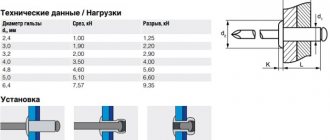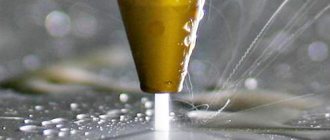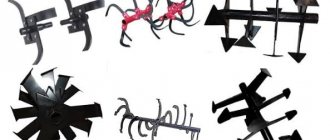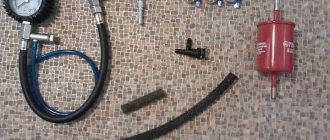Operating principle
A water-cooled plasma cutter is used in air plasma cutting machines. It serves to convert electric current into plasma and has a complex design with many structural elements.
Structurally, the plasma torch consists of the following elements:
- An electrode (aka cathode) with an insert made of a refractory metal (usually zirconium or hafnium).
- A nozzle for forming a plasma jet, which is usually isolated from the electrode.
- A swirler is a special mechanism for swirling the flow of plasma-forming gas.
- Chambers for supplying gas and circulating cooling water throughout the device.
- Insulating sleeve to isolate the nozzle from the cathode.
- PTFE body, casing.
Figure 1. Design diagram of a standard plasma torch
The cathode and nozzle are considered consumables and typically wear at the same rate. They wear out relatively quickly - when cutting rolled metal up to 10 mm thick, one set is usually enough for a full 8-hour shift. It is recommended to replace them simultaneously and in a timely manner, otherwise the quality of the cut will gradually decrease.
Photo 2. Appearance of the cathode
Photo3. Nozzle appearance
The principle of operation of a water plasma torch is based on the ionization of a plasma-forming gas in the discharge chamber with the subsequent removal of the formed plasma arc to the surface of the metal being cut. The process itself begins with the ignition of a pilot arc, which is formed between the cathode and the nozzle due to the supply of increased voltage. Its main function is to provide the ability to create a cutting arc, which is formed after the duty arc touches the surface of the workpiece.
Figure 4. Electrode and nozzle during plasma arc cutting process
A directed jet instantly heats the rolled material to the melting temperature and blows the molten metal out of the cutting zone. To cut out a part with certain dimensions, the plasma torch moves along the appropriate contour. At the same time, in order to obtain a high-quality cut during the work, it is necessary to maintain a constant gap between the workpiece and the plasma cutter.
Photo 5. The process of plasma cutting of sheet metal
Plasma cutting using water
Plasma cutting using water is increasingly used. Water has the following advantages: firstly, it improves the hygienic working conditions of workers, secondly, it improves the quality of the edges of cut parts, and thirdly, when plasma cutting using water, thermal deformations of parts are reduced. In addition, under certain conditions, the use of water for plasma cutting provides a high concentration of energy and an increase in cutting speed.
Depending on the goal, plasma cutting using water is divided into three main methods:
- 1) cutting metal immersed or semi-immersed in a water bath;
- 2) use of water as a plasma-forming medium (water-electric cutting);
- 3) supplying a small amount of water into the plasma column.
Plasma cutting of metal with immersion of the cut sheet in water allows you to reduce harmful gases (ozone, nitrogen oxides) to a minimum and completely eliminate the abundant smoke and aerosols. Metal and slag melted from the cutting cavity fall into the water and settle to the bottom of the bath in the form of small particles and drops. A variation of this method is to create an additional water screen around the plasma arc. In this case, the sheet being cut is usually semi-immersed in a water bath. A dense water screen around the plasma is created by a special nozzle attached to the plasma torch. When cutting corrosion-resistant steel 12.7 mm thick with a 65 kW arc at a distance of 1.83 m from the plasma torch, under normal conditions, the noise level reached 108 dB. In the case of shielding with protective means (metal casing), the noise decreased to 101 dB. When screened due to a powerful water flow (water flow up to 1.2 l/s), the noise decreased to 15 dB, i.e. became significantly lower than the established standards. When the water flow rate was reduced to 0.6 l/s, the noise intensity increased significantly (up to 93 dB). Using the system (a table filled with water), it is possible to remove 99.5% of the released gases. The burr and molten metal are collected in a tank filled with running water.
Plasma cutting with plasma arc stabilization by water (water-electric) is used for cutting various metals and alloys. In a plasma torch with water arc stabilization, water vortex is ensured using a channel limited by two nozzles. In this case, only water is used; gas is not supplied to the plasmatron. The nozzle edges are protected from the thermal effects of the arc by a thin film of water. Water is the best medium for cutting non-ferrous metals and thick high-alloy steels. Water in the arc dissociates into oxygen and hydrogen, and then into atomic oxygen and hydrogen. The concentration of hydrogen and oxygen in the arc column is optimal, i.e., such that the best cut quality is obtained with high cutting productivity.
The thermal insulation properties of water are higher than those of gases, since between the arc column and the layer of water directly adjacent to the inner walls of the nozzle, a constantly renewed vapor layer is formed, the formation of which consumes most of the arc heat, moving in radial directions from the arc column. In this regard, by selecting the appropriate water flow, it is possible to create a water layer on the inner wall of the nozzle. The arc column is stabilized and isolated from the nozzle walls by water. Therefore, the permissible loads for the same nozzle diameter limiting the plasma arc column are several times higher, which can be illustrated by the following data:
| Nozzle diameter, mm | 3 | 4 | 5 | 6 |
| Allowable current, A: | ||||
| for gas-electric cutting | 360 | 400—480 | 600 | 750 |
| with water-electric | 900 | 1200 | — |
The use of a nozzle less than 3 mm is impossible due to the fact that aluminum wire with a diameter of 1.5 mm is used to ignite a water-electric arc and with smaller nozzle diameters the outflow of water is disrupted at the moment the arc is ignited.
Cuts made by plasma cutting using water are distinguished by high quality edges that have a slight bevel and a metallic sheen, i.e., the most active elements of the metal being cut do not burn out from the surface of the edges. Metal reduces its natural color. The grooves on the edges of the chips have moved away somewhat, but they have smooth transitions from ridge to cavity. The disadvantage of water-electric cutting is the difficulty of exciting the arc and starting the process. A graphite electrode is used, which is quickly consumed. In this regard, an additional device is necessary to vertically move the graphite electrode in the direction of the nozzle during the cutting process. All this makes the process insufficiently technological and reliable. It cannot yet be used on computer controlled machines. The water-electric cutting process, with appropriate improvements in equipment, can find wider application.
Plasma cutting, which involves feeding a small amount of water into the plasma, most often nitrogen and air, is becoming more widely used.
Foreign companies most often use nitrogen as the main gas for this cutting method; in our country, nitrogen and air are used. Water supply to the arc column is carried out in various ways. Water can be directed radially into the plasma arc column below the nozzle exit. In this case, the flow rate, speed pressure of water jets, as well as the angle of attack of radially directed water jets can be different. Under these conditions, the water cools and limits the plasma column, which tends to expand as it exits the nozzle. Water under the influence of high temperature cannot dissociate as completely and manifest its properties in the same volume as with the water-electric cutting method, in which it is exposed to the thermal influence of a high-temperature arc in the closed volume of the cavity and nozzle channel.
Special designs of plasma torches have been developed that make it possible to more fully use the valuable properties of water. Since water cannot be supplied together with the plasma-forming gas into the cathode space, since this leads to destruction of the electrode and nozzle, it is supplied separately: gas into the nozzle cavity, and water into the nozzle channel. In the nozzle channel, under the influence of high temperatures, intense evaporation occurs, i.e., dissociation into hydrogen and oxygen. When 1 cm3 of water evaporates, about 1700 cm3 of water vapor is formed. The plasma arc thickens, lengthens and stabilizes. In addition, the driving mass is increased, which provides better energy transfer and serves to remove molten metal and slag from the cutting cavity.
From numerous literature data it is known that the use of water for plasma cutting or adding it in small quantities to the plasma-forming gas significantly improves the quality of edges, reduces their bevel, and reduces thermal deformation of the metal.
Features of a plasma torch on water
A plasma torch is a device that is subject to high thermal loads. Correct operation of the cooling system of a water plasma cutter ensures a longer service life of consumables and prevents heating and melting of the main elements of the device.
The main heat sources in the plasma torch design include the electrode and power cables in the hose package. A plasma arc is connected to the surface of the cathode, resulting in a large amount of energy being applied to the small metal part. Therefore, the electrode is continuously cooled - coolant constantly circulates along its back side.
The power cables in the hose package have a small cross-section relative to the current passing through them, so they generate a large amount of heat. To avoid overheating and melting of the insulation, coolant also circulates through the hose package.
Figure 6. Schematic diagram of plasmatron water cooling
Cooling principle of the plasma cutter:
- The coolant inside the device is initially in contact with the electrode. It has a small hole for liquid flow, which ensures high flow rate along the back wall and efficient heat dissipation.
- Then the coolant is directed into the plasma torch body, and from there through another channel to the nozzle.
- After this, the refrigerant is returned through the hose package to the cooling device.
Burner device
The main element of the burner is a metal body made of stainless steel. Inside the battery housing there is a moisture-absorbing material based on a non-woven fabric made from quartz water-dispersible fibers. The battery is filled with this fiber. In the same way as in a regular felt-tip pen, it retains moisture and, under the action of capillary forces, it is supplied to the working area, where there are rings made of moisture-absorbing material “Monex”, which supply moisture to the evaporator. The latter transfers the thermal energy of the working fluid, evaporates it and the vapors participate in the process of plasma formation.
The second main element of the torch is the starting device, which is used to start and regulate the voltage in the arc. It is a small plastic housing on which a rod, an O-ring and a cathode holder axis are located. When you press the button, the axis moves and along with it the cathode wound onto it. When we press the button, the cathode moves and closes with the nozzle. When leaving, an electric arc is excited, which heats the steam to an ionization temperature of up to 10,000 degrees. Plasma is formed, which comes out through the nozzle and, in fact, with the help of which the material is processed.
Differences from closest analogues
A cooling system is provided in each plasma cutting machine. There are several types of it - air and water. Plasmatrons with a mixed system are also produced. However, water-cooled plasma cutters are more often used.
Plasma torches with a water autonomous cooling system for heat-loaded components are designed for higher power and increased intensity of operation. At the same time, they are distinguished by a rather complex design and a large number of components. They are also characterized by significant weight and dimensions compared to analogues.
Devices with a mixed cooling system for the plasma-forming nozzle and cathode are smaller, lighter, and simpler in design. But at the same time, cooled components have a shorter service life due to electrochemical erosion. Also, when working with such plasma torches, the probability of double arcing increases.
Main technical characteristics of the Distiller “Garynych”
Main characteristics of the device:
- The capacity of the distillation cube (12 l cubic capacity), like the other elements, is made of stainless steel, the thickness of which is 1 mm. The bottom is made of magnetic stainless steel, which allows the distiller to be used on induction cookers.
- Stiffening ribs prevent bending during operation, and also achieve uniform and stable heating.
- Height when assembled – 65 cm.
- The diameter of the cube is 26 cm.
- Distiller productivity – 2 l/hour.
Types of plasma devices
Water plasma cutters for plasma cutting are available in different types according to design and technical characteristics. Therefore, you need to select a device taking into account the thickness of the material being cut and the maximum operating parameters of the power source from which the plasma torch will operate.
Photo 7. The process of separation cutting with a water plasma cutter
Typically, water-cooled plasma cutters are used in conjunction with power supplies whose operating current exceeds 100 A. These include professional models designed for long-term continuous operation in production conditions.
The design of standard plasma torches for manual and mechanized cutting, where the operating current does not exceed 100 A, includes an air cooling system. At such operating parameters, less heat is generated, so conventional air cooling is sufficient for the device.
Photo 8. Process of manual plasma cutting of sheet metal
Classification of plasma torches by purpose:
- For manual cutting - supplied assembled with a cable-hose package, inside of which there are power cables for connecting to a power source and tubes for coolant circulation.
Photo 9. Appearance of the device for manual plasma cutting.
- For automatic cutting – they are installed on special transverse movement mechanisms in the design of industrial equipment.
Photo 10. Plasma cutter installed on a gantry plasma cutting installation
On automated CNC plasma cutting lines, the plasma torch is installed on a special portal unit, which ensures the movement of the working head in the transverse and longitudinal direction. The design of hand-held plasma torches does not provide for the possibility of stationary mounting - during the work process, the cutter holds the device in his hands.
What are the obvious disadvantages of the device?
Although at first glance everything looks quite reliable, stable and productive, the Gorynych moonshine still has its own individual flaws and shortcomings. You need to pay attention to them when purchasing:
- The steam steamer and the bubbler are connected to each other by a tube and a cone-shaped nut. The lack of a gasket here results in a leak. therefore, distillers must come up with something during operation. Some people use fum tape to create an airtight connection.
- Welding is not reliable enough. Rough work not only does not look aesthetically pleasing. In some places, on some units, holes may form through which mash will ooze out a little.
- Users note distortions in the design. The entire distiller system may tilt slightly when placed on the stove.
- Also, the tank itself uses fairly thin metal during production. As a result, when heated, the mash can stick to the walls and bottom. Not to mention that with prolonged and intense heating, the tank itself may become somewhat deformed. An inexperienced user should take into account that many modern distillers use steel with a thickness of 1.2 or 1.5 cm.
- Also, the filler neck is quite narrow. Its diameter is only 3.5 cm. Therefore, it is quite difficult to clean the container after the distillation process from mash residues.
What kind of work is it suitable for?
Plasmatrons with a water cooling system are designed for separation cutting of rolled metal of different grades and thicknesses, as well as non-ferrous metals and their alloys. They are used for both straight and figured cutting. They are used primarily in the design of industrial equipment for plasma cutting.
Devices of this type are used in various industries:
- construction and metallurgical industry;
- heavy engineering;
- production of metal structures;
- aviation, automobile, shipbuilding, etc.
Photo 11. An example of using a portal automatic installation in a factory environment
Using plasma torches on water, you can cut steel with any content of carbon and alloying elements, cast iron, copper, aluminum, alloys based on them, and even titanium. The main thing here is to choose the right mixture of gases and set the operating parameters (cutting current, gas pressure, etc.).
Technical characteristics and equipment
Plasma torches are produced in different types, therefore they differ in characteristics. When choosing, you must be guided by the operating parameters of the power source with which the device will work.
Main technical characteristics of a water plasma cutter:
- rated operating current;
- type of plasma-forming gas;
- gas inlet pressure;
- air flow;
- inlet water pressure;
- water consumption.
Photo 12. Different types of consumables for the plasma torch
Plasma cutters are supplied assembled, their equipment is standard – i.e. All structural elements of the device are available. The kit also includes gaskets (depending on the modification), a product passport with a warranty card and related documentation.
Manufacturer
Today, water-based plasmatrons are produced by many foreign and domestic manufacturers. But choosing a truly reliable device is quite difficult, since there are a lot of fakes and uncertified products on the market.
The PURM group of companies is the official manufacturer of welding equipment, devices and machines for plasma cutting. Each device is developed taking into account the harsh Russian operating conditions and is suitable for operation in any climatic zones.
Photo 13. Different types of power supplies from the domestic manufacturer PURM
The company specializes in serial production of certified equipment, supply of components, spare parts and consumables. If necessary, we carry out supervision of installation of plasma cutting machines and production lines, commissioning, warranty and post-warranty maintenance.
power unit
The main working element is two transformers; they do not contain windings in the form in which they are found in a conventional transformer. These windings are made in the form of printed circuit boards and there is practically no copper in them. The current density reaches 75 A/mm2, but losses are minimal, which allows this unit to have a high efficiency of more than 95%. The fuses inside act as fire protection.
A thermal sensor is installed on the massive radiator, which protects the power supply from overheating.
The unit is protected by an electronic interference filter, which prevents the transmission of all kinds of electronic interference, both from the network, and the transmission of interference to the network from the power supply itself, which has a beneficial effect on operating conditions.
Where can I buy?
You can buy a water plasma torch suitable for specific purposes directly on the website of the PURM Group of Companies with delivery using transport companies. Pickup is also possible (free of charge), but in this case you need to first agree on the place, date and time of receipt - if a third party is picking up, you will additionally need a power of attorney to receive the goods.
The assortment includes different types of water-based plasma torches:
- For automatic cutting - P3-400VA, P2-400VR, PVR-180, PVR-402M, PVR-412 and others.
- For manual cutting – KSh5V-P3-VA and KSh3V-P2-VR assembled with cable and hose packages 10 and 20 m long.
The company's employees will advise on the choice and help you choose a plasma cutter depending on the technical characteristics of the available power source. If necessary, you can order a set of equipment for specific production tasks - an automatic CNC machine or a standard manual machine.
Gorynych – what’s better?
If we consider the advantages of this device, it is worth noting the following points:
- Thanks to the physicochemical properties of the material used in the bottom of the distiller, uniform heating is ensured.
- A 1 m long refrigerator facilitates intensive cooling of the finished product.
- In addition, the Gorynych moonshine still can be used on gas, electric and induction furnaces. You can also put it on an open fire or stoves running on solid fuel.
Considering the moments and price of a moonshine still, many distillers purchase it to work on the production of alcohol.
Dealer's page ( Goryn.rf )











